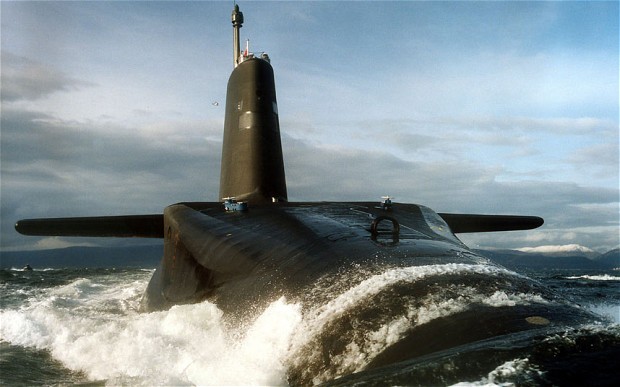A Trident submarine is on patrol 24 hours a day 365 days a year with the mission of remaining undetected and constantly in receipt of communications so that it is ready to fire when ordered.
This aim has been achieved ever since the first Polaris submarine went on patrol in April 1969
|
HMS Vanguard - UK's lead Trident armed submarine |
The UK's nuclear deterrent force currently consists of four Vanguard-class submarines each capable of carrying up to 16 Trident II D-5 ballistic nuclear missiles.They are very big - about twice the displacement of a T45 daring class destroyer or a sea going block of flats!
The missiles belong to a common pool managed by the US Government at their Kings Bay facility in the USA.
The independent cross party study group British American Security Council (BASIC) concluded in their July 2014 Report that "If the United States were to withdraw their co-operation completely, the UK nuclear capability would probably have a life expectancy measured in months".
At least one submarine is constantly on patrol, while one undergoes maintenance and the other two carry out training and work up thereby achieving the aim of Continuous at Sea Deterrence. However, as of September 2020, HMS Vanguard has been in Devonport Dockyard since 2015 for a reactor refuelling not originally intended and which appears to have serious problems with completing.
Each submarine can carry 16 missiles capable of hitting a target up to 7,500 miles away. Each missile can carry 8 warheads capable of being independently targeted. Each of these warheads has an explosive force roughly equivalent to 6 x Hiroshima. The lethality of Trident warheads (compared to its Polaris predecessor) is tabulated HERE.
However, UK has voluntarily reduced the misile load out to 8 per submarine with a maximum of 40 warheads in total. The replacement Dreadnought class will have 12 missiles tubes.
The missiles have been stood down at 'several days notice to fire' and war heads have been un-targeted since the mid 1990s.
If you wish to see what devastation the blast and the fireball will do go to this website. One Trident warhead is 100Kt so use that figure. Remember that this takes no account of airborne long term radiation which will travel hundreds of miles down wind.
The current fleet will start to be phased out in 2028. It is estimated that the cost of replacing the submarines and running them for over 20 years will cost in excess of £165Bn.
Back to Home Page Questions & Answers
UK Dependency on US Can UK afford Trident? Further reading
